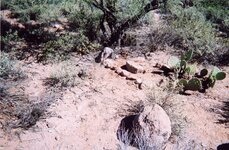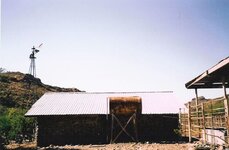Matthew Roberts
Bronze Member
In a previous thread there was some confusion about a location known as the "Milk Ranch" which is confused by some with the Cavaness Ranch or the Board House Ranch.
Matt Cavaness was the first man to run cattle on the Superstition Mountains range. Around 1871 he founded what was known as the Cavaness ranch or the Board House ranch as it was sometimes called. This is the same ranch later owned by George Marlow, Jim Bark, Tex Barkley and today Charles Backus. In Cavaness day it operated with the "River" brand, later the ranch took the JL brand and later became the Quarter Circle U ranch. The ranch is located in the foothills of the south end of the Superstition Mountains.
Matt Cavaness was married to Alice Rowe and had three young boys living at the ranch, Anson, Albert and Aaron. Matt Cavaness wife Alice was a daughter of William Rowe who lived on the McDowell crossing of the Salt River. This ferry crossing of the Salt was the main crossing on the Gila to Fort McDowell wagon road. A small community grew up at the crossing first known as Rowe's Station and later Maryville (named for one of Wm. Rowe's daughters). Rowe's station was on the south side of the Salt River. Later the Mormon town of Lehi would be located there on the north side.
William Rowe had a large family, a wife and 8 children. Apache raids on Rowe's Station in the early days drove many settlers out of the area. On March 28, 1874 Apache's raided the Station, burned some buildings and stole every head of stock. Less than a month later, on April 14, 1874 Paul Handel and Edwin Toomey left Fort McDowell for Phoenix and were captured by the Apache within a few miles of Rowe's Station, horribly tortured and killed. William Rowe sent his wife and several of their children to live with their daughter Alice and Matt Cavaness at the Cavaness ranch where they would be safe.
Matt Cavaness had originally built a stone house at his ranch. But following a trip to San Diego when he hauled some ore to be refined there, he returned with a load of lumber and built a board house at the ranch. This was one of the first board houses in the territory including the town of Phoenix. His ranch became known to some as the "Board House" ranch.
With that load of lumber Cavaness also built another house and corral about a mile or two to the east of his ranch. This house became known as the Milk House Ranch and it was at this location where Matt's mother-in-law Mrs. William Rowe, and her children came to stay. The place was called the "Milk Ranch because William Rowe's main source of income was raising hay for the Army and selling milk. With the Apache stealing stock at Rowe's Station it became impossible for Wm. Rowe to earn any money selling milk. So William Rowe and Matt Cavaness stocked the Milk House Ranch with milk cows and Mrs. Rowe and her children used the proceeds from the sale of the milk to live.
The Cavaness ranch and the Milk ranch were two separate places a few miles distant from each other. Both owned and built by Matt Cavaness and his wife Alice Rowe-Cavaness. The Cavaness ranch is today commonly known as the Quarter Circle U Ranch. The Milk House and ranch is gone today, nothing is left of it except desert.
It was the Cavaness Board House where Jacob Waltz stated he had gone for supplies and made the round trip from his mine to the ranch and back again in a day. Waltz didn't state however if that trip took him all day or just part of a day. It is assumed by some to have meant it took him the entire day to make the trip.
Hopefully this clears up any confusion about the Milk Ranch from the Matt Cavaness time period.
Matthew
Matt Cavaness was the first man to run cattle on the Superstition Mountains range. Around 1871 he founded what was known as the Cavaness ranch or the Board House ranch as it was sometimes called. This is the same ranch later owned by George Marlow, Jim Bark, Tex Barkley and today Charles Backus. In Cavaness day it operated with the "River" brand, later the ranch took the JL brand and later became the Quarter Circle U ranch. The ranch is located in the foothills of the south end of the Superstition Mountains.
Matt Cavaness was married to Alice Rowe and had three young boys living at the ranch, Anson, Albert and Aaron. Matt Cavaness wife Alice was a daughter of William Rowe who lived on the McDowell crossing of the Salt River. This ferry crossing of the Salt was the main crossing on the Gila to Fort McDowell wagon road. A small community grew up at the crossing first known as Rowe's Station and later Maryville (named for one of Wm. Rowe's daughters). Rowe's station was on the south side of the Salt River. Later the Mormon town of Lehi would be located there on the north side.
William Rowe had a large family, a wife and 8 children. Apache raids on Rowe's Station in the early days drove many settlers out of the area. On March 28, 1874 Apache's raided the Station, burned some buildings and stole every head of stock. Less than a month later, on April 14, 1874 Paul Handel and Edwin Toomey left Fort McDowell for Phoenix and were captured by the Apache within a few miles of Rowe's Station, horribly tortured and killed. William Rowe sent his wife and several of their children to live with their daughter Alice and Matt Cavaness at the Cavaness ranch where they would be safe.
Matt Cavaness had originally built a stone house at his ranch. But following a trip to San Diego when he hauled some ore to be refined there, he returned with a load of lumber and built a board house at the ranch. This was one of the first board houses in the territory including the town of Phoenix. His ranch became known to some as the "Board House" ranch.
With that load of lumber Cavaness also built another house and corral about a mile or two to the east of his ranch. This house became known as the Milk House Ranch and it was at this location where Matt's mother-in-law Mrs. William Rowe, and her children came to stay. The place was called the "Milk Ranch because William Rowe's main source of income was raising hay for the Army and selling milk. With the Apache stealing stock at Rowe's Station it became impossible for Wm. Rowe to earn any money selling milk. So William Rowe and Matt Cavaness stocked the Milk House Ranch with milk cows and Mrs. Rowe and her children used the proceeds from the sale of the milk to live.
The Cavaness ranch and the Milk ranch were two separate places a few miles distant from each other. Both owned and built by Matt Cavaness and his wife Alice Rowe-Cavaness. The Cavaness ranch is today commonly known as the Quarter Circle U Ranch. The Milk House and ranch is gone today, nothing is left of it except desert.
It was the Cavaness Board House where Jacob Waltz stated he had gone for supplies and made the round trip from his mine to the ranch and back again in a day. Waltz didn't state however if that trip took him all day or just part of a day. It is assumed by some to have meant it took him the entire day to make the trip.
Hopefully this clears up any confusion about the Milk Ranch from the Matt Cavaness time period.
Matthew









